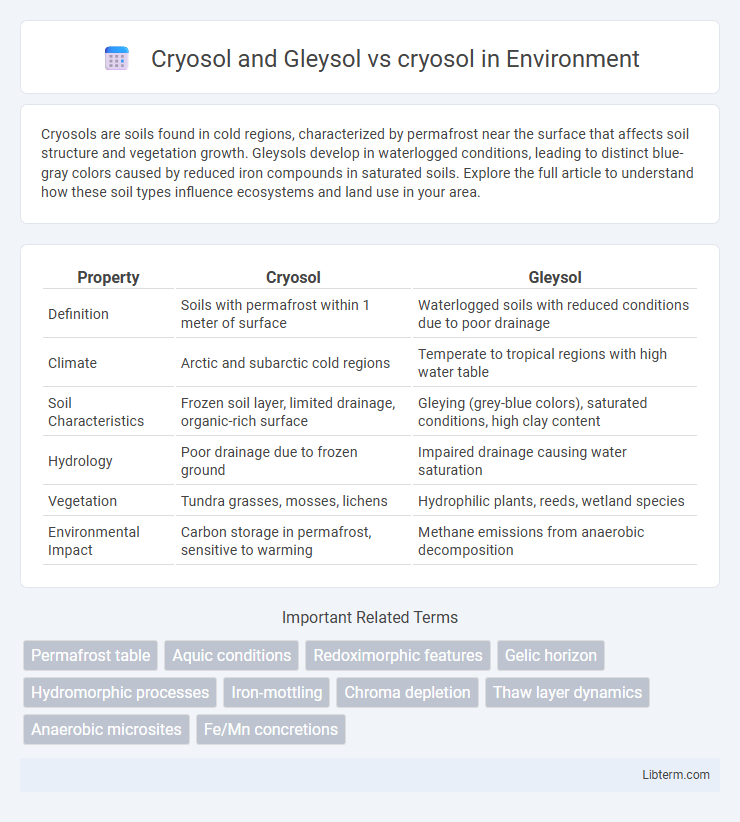Cryosols are soils found in cold regions, characterized by permafrost near the surface that affects soil structure and vegetation growth. Gleysols develop in waterlogged conditions, leading to distinct blue-gray colors caused by reduced iron compounds in saturated soils. Explore the full article to understand how these soil types influence ecosystems and land use in your area.
Table of Comparison
| Property | Cryosol | Gleysol |
|---|---|---|
| Definition | Soils with permafrost within 1 meter of surface | Waterlogged soils with reduced conditions due to poor drainage |
| Climate | Arctic and subarctic cold regions | Temperate to tropical regions with high water table |
| Soil Characteristics | Frozen soil layer, limited drainage, organic-rich surface | Gleying (grey-blue colors), saturated conditions, high clay content |
| Hydrology | Poor drainage due to frozen ground | Impaired drainage causing water saturation |
| Vegetation | Tundra grasses, mosses, lichens | Hydrophilic plants, reeds, wetland species |
| Environmental Impact | Carbon storage in permafrost, sensitive to warming | Methane emissions from anaerobic decomposition |
Introduction to Cryosol and Gleysol
Cryosols are permafrost-affected soils found in cold regions, characterized by frozen ground conditions that influence soil processes and vegetation growth. Gleysols develop in waterlogged environments with reduced oxygen levels, resulting in distinctive blue-grey colors due to iron reduction. Both soil types play crucial roles in cold-climate ecosystems and carbon cycling, with Cryosols dominating permafrost landscapes and Gleysols commonly occurring in poorly drained areas.
Defining Cryosol: Key Characteristics
Cryosol is a soil type characterized by the presence of permafrost within two meters of the soil surface and typically contains frozen organic layers, distinguishing it from non-permafrost soils. Key characteristics include a cryoturbation process causing mixed soil horizons and a low soil temperature that restricts microbial activity and nutrient cycling. In contrast, Gleysol soils are waterlogged soils with reducing conditions, often found in wetlands, lacking the permafrost layer that defines Cryosol.
Understanding Gleysol: Essential Features
Gleysol is characterized by its waterlogged conditions leading to anaerobic soil environments, which cause distinctive blue-grey colors due to iron reduction. This soil type is typically found in wetlands and areas with poor drainage, affecting plant root respiration and nutrient availability. Understanding Gleysol's hydric properties is essential for managing wetland ecosystems and improving land use in flooded regions.
Cryosol vs. Gleysol: Main Differences
Cryosol and Gleysol are soil types with distinct characteristics and environmental conditions. Cryosols form in cold climates with permafrost and exhibit frozen layers affecting soil structure and nutrient availability, while Gleysols develop in waterlogged, anaerobic conditions leading to reduced iron and characteristic gleyed colors. The main differences between Cryosol and Gleysol lie in temperature regime and drainage: Cryosols are defined by continuous permafrost presence and low temperature impact, whereas Gleysols are characterized by poor drainage and saturation with groundwater, influencing soil chemistry and vegetation types.
Formation Processes: Cryosols Compared to Gleysols
Cryosols form primarily in cold regions where permafrost influences soil development, characterized by frozen ground that restricts drainage and promotes ice lens formation. Gleysols develop in waterlogged, poorly drained environments, resulting in anaerobic conditions that cause iron reduction and distinctive grey-blue soil colors. While Cryosols' formation is driven by frost processes and low temperatures, Gleysols arise from prolonged saturation and reducing conditions in wetland or floodplain areas.
Geographic Distribution: Where Cryosols and Gleysols Occur
Cryosols predominantly occur in high-latitude regions such as Alaska, Siberia, and northern Canada, characterized by permafrost and cold climates. Gleysols are typically found in low-lying, waterlogged areas worldwide, including river valleys, wetlands, and coastal plains, where poor drainage leads to reducing conditions. The geographic distribution of Cryosols is mainly polar and subpolar zones, while Gleysols span temperate to tropical regions with saturated soil environments.
Physical and Chemical Properties: A Comparative Overview
Cryosols exhibit permafrost presence with frozen soil layers, impacting water retention and nutrient availability, while Gleysols develop under waterlogged conditions, showing reduced oxygen and distinctive greyish colors from iron reduction. Physically, Cryosols often have coarse textures and ice lenses, leading to low permeability, whereas Gleysols display fine textures and poor drainage with high water content. Chemically, Cryosols maintain low microbial activity and nutrient cycling due to cold temperatures, contrasted by Gleysols' anaerobic conditions that promote unique redox reactions and accumulation of organic matter under saturated environments.
Ecological Significance of Cryosols and Gleysols
Cryosols, characterized by permafrost and frozen ground, play a vital ecological role in carbon storage, significantly impacting global climate regulation by sequestering large amounts of organic carbon. Gleysols, formed under waterlogged conditions, support diverse wetland ecosystems by maintaining high soil moisture levels that facilitate nutrient cycling and provide habitats for specialized flora and fauna. The interaction between Cryosols' frozen state and Gleysols' saturated environments influences permafrost thaw dynamics, affecting greenhouse gas emissions and biodiversity in cold region ecosystems.
Land Use and Management Challenges
Cryosol and Gleysol soils present distinct land use and management challenges due to their unique physical properties. Cryosols, characterized by permafrost and seasonal thawing, impose limitations on agriculture and infrastructure development because of soil instability and restricted drainage. Gleysols, formed in waterlogged conditions with reduced aeration, require careful drainage management to prevent crop root oxygen deficiency and are typically suited to wetland agriculture or pasture.
Climate Change Impacts: Cryosol and Gleysol Responses
Cryosols, characterized by permafrost soil layers, and Gleysols, known for their waterlogged conditions, respond differently to climate change impacts such as rising temperatures and altered precipitation patterns. Thawing permafrost in Cryosols leads to increased greenhouse gas emissions like methane and carbon dioxide, accelerating global warming, while Gleysols experience intensified water saturation fluctuations affecting soil redox processes and nutrient cycling. These divergent soil responses significantly influence ecosystem carbon dynamics and hydrological regimes in cold region landscapes under climate change scenarios.
Cryosol and Gleysol Infographic

 libterm.com
libterm.com